|
Ethnic groups and discrimination |
Post war immigration |
|
According to Robert Cohen in Contested Domains: Debates in International Labour Studies during the post war period all Western countries encouraged immigration in order to replenish the labour force. For example, Sauvy, the demographer of the Institut National d'Études Démographiques, estimated that France needed 5.3 million permanent immigrants. West Germany initiated a guestworker programme inviting immigrant workers from Turkey. The US encouraged migrant labourers from Central America. Japan, however, did not encourage immigration by rather employed women instead. In Japan female employment rose from 3 million in 1950 to 12 million in 1970.
|
|
|
The end of the migrant labour boom occurred throughout Europe around the mid 1970s, and was affected by six factors: (1) The oil crisis associated with the end of the post-war boom, initiated by the 1974 Yon Kippur war. (2) The rise of virulent indigenous working-class xenophobia, making it difficult for private enterprise and the state to employ immigrant workers. (3) Migrant workers began to form community associations, religious groups and political support groups and to resist to a limited extent moves towards repatriation, return migration, immigration restrictions and deportations. (4) There was a rising cost to society of migrant labour, making it less cheap as a factor of production. The cost rose because immigrants began to make claim to the full benefits of membership of society. (5) Changing technology resulted in deindustrialisation. Globalisation meant that in traditional industries the competitive advantage shifted to the Asian Rim – Hong Kong, Korea, Taiwan and Singapore. (6) Importing migrant labour came to be viewed as an inefficient way of reducing industrial costs. However, it is not true, according to Cohen, that immigrant manual labour was less efficient than native manual labour.
|
|
|
Since the mid 1970s there have been continuing inflows of migrant labour — these have been due to family reunification, refugees and illegal immigrants.
|
|
|
In Britain most black immigration has taken place since 1945. Even in 1953 according to Civil Service estimates there were only 15,000 people of West African ethnic origin in Britain, 9,300 of Indian or Pakistani orgin and 8,600 of West Indian origin. However, the labour shortage after the Second World War encouraged employers to recruit from former British colonies. London Transport recruited from the Barbados, Trinidad and Jamaica. In 1958 there were race riots — clashes in Notting Hill in London between Afro-Caribbean ethnic groups and local whites. In 1962 the Conservative Government introduced the Commonwealth Immigrants Act. This created a system of vouchers that restricted migration to Britain — class A vouchers were issued to migrants who could demonstrate that they had the offer of work before they arrived in Britain; class B vouchers were issued to those who had professional skills that Britain required, such as medical skills; class C vouchers went to those who had some claim to special merit, such as those who had served in the British armed forces. The Labour government of 1965 maintained this immigration policy and in fact imposed further restrictions on immigration. The 1968 Commonwealth Immigration Act restricted entry to Britain for East African Asians holding British passports. Kenyan whites were allowed to enter Britain, but Kenyan Asians were subject to severe restrictions. The 1971 Immigrations Act replaced employment vouchers with work permits, and these did not grant permanent residence to the holders. The Thatcher government introduced further restrictions and in the 1981 British Nationality Act defined three categories of citizenship being (a) British, (b) British Dependent Territories and (c) British Overseas. The 1988 Immigration Act imposed further restrictions on the families of immigrants joining workers already settled in Britain. Immigration into Britain from New Commonwealth countries declined as a result. It should also be noted that immigration into Britain is not a question of solely black immigration. The majority of immigrants are from the New Commonwealth and are white.
|
|
Ethnic population in Modern Britain |
|
In Britain the 1991 Census was the first to identify people according to ethnic group. They asked a number of questions inviting respondents to identify the ethnic group to which they belonged. The questions are subject to serious criticism; however, the census was the first more or less reliable indication of the ethnic origin of people in Britain. The results and proportions were as follows.
|
|
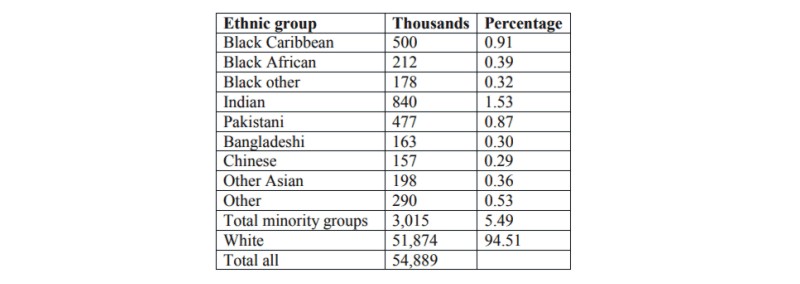
|
|
British Census 1991
|
|
|
The distribution of ethnic minorities is not even throughout the country. In 1991 more than 50% of the ethnic population lived in the South East of England, whilst there was less than 1% living in Scotland, Wales, the South West and the North.
|
|
|
The following table gives the 2002 Census, Population by ethnic group [Source: 2002 Census, Office for National Statistics.]
|
|
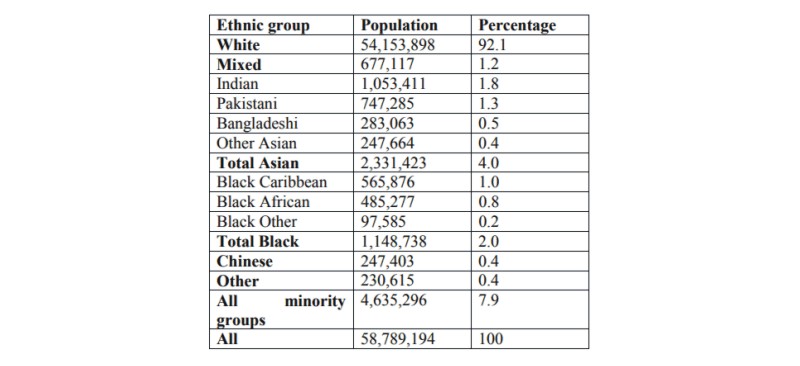
|
|
British Census, 2001
|
|
|
Ethnic groups and the labour market |
|
The thesis that ethnic minorities are disadvantaged in the British labour market is strongly supported by statistical and other evidence. The Policy Studies Institute published results of its research conducted during 1988-90. This compares employment rates between different ethnic groups as follows.
|
|

|
|
Male employment (percentage) by ethnic group, 1988-90
|
|
|
This shows that ethnic minorities tend to be employed more in low status occupations. The African Asians form a distinct category that runs counter to this trend. The same pattern holds for female employment; however, women are generally more likely to hold lower status occupations.
|
|

|
|
Female employment (percentage) by ethnic group, 1988-90
|
|
|
More recent statistics indicate that members of ethnic groups are more likely to become unemployed.
|
|

|
|
All unemployment (percentage) by ethnic group, 2001, 2004 [Source: British Social Trends.]
|
|
|
Different ethnic groups are more likely to be self employed
|
|

|
|
Self-employed (percentage) by ethnic group, 2001, 2004 [Source: British Social Trends.]
|
|
|
In research conducted by Colin Brown and Pat Gay (1984-5) carried out in London, Birmingham and Manchester, fake job applications were made by letter and telephone in which the supposed applicant was identified as white or as belonging to an ethnic minority group. 90% of the white 'applicants' received a positive reply, but only 63% of Asian and 63% of West Indian 'applicants' received a positive reply.
|
|
|
There is also evidence that members of ethnic minorities are discriminated against when it comes to promotion on the grounds of their membership of an ethnic group. There is also some evidence from the 1982 Policy Institute Survey that men from ethnic groups are likely to be paid less than white men for the same work.
|
|
Ethnic minorities and crime |
|
Members of ethnic groups are also much more likely than whites to be both the victims of crime and to be arrested and imprisoned for crime. The June 1992 prison population comprised 9.6 individuals per 100,000 for whites, but 76.7 for West Indians, Guyanese and Africans. Ethnic minorities are much more likely than whites to be the victims of racially motivated attacks.
|
|
|
Consider, for example, statistics relating to the prison population of England and Wales.
|
|
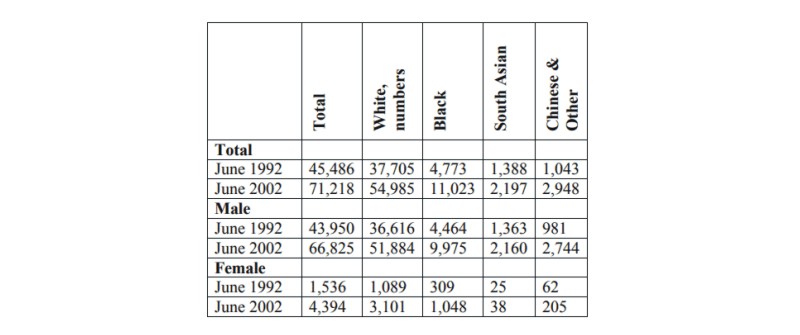
|
|
Prison Population (numbers)
|
| England & Wales [Source: Home Office Prison Statistics of England & Wales.]
|
|
|
Combining this with the population statistics from the 2002 census indicates that members of certain ethnic groups are much more likely to end up in prison.
|
|
|
|
|

|
|
Prison Population (prisoners per 100,000 population)
|
|
England & WaleS [Source: Home Office Prison Statistics of England & Wales/]
|
|
|
The following tables indicate that members of certain ethnic groups are much more likely to receive a custodial sentence.
|
|

|
|
Adult offenders — June 2002
|
|
Percentage sentenced to 4 years or more by ethnic group [Source: Home Office Prison Statistics of England & Wales.]
|
|
|
|
|

|
|
Young offenders — June 2002
|
|
Percentage sentenced to 12 months or more by ethnic group [Source: Home Office Prison Statistics of England & Wales.]
|
|
Ethnic minorities and education
|
|
|
Pupils from ethnic backgrounds generally have lower educational attainment than white pupils. Asians are less behind than other ethnic groups. The Bangladeshi are particularly disadvantaged. Thus 1981/2 percentage of school leavers with 5 or more graded GCSE results: 23% was the national average; 17% Asian; 6% West Indian. In recent years ethnic minorities have tended to stay on in full-time education longer than whites. For example, in 1988 — 90 37% white compared to 43% West Indian; 66% Asian. But these differences are probably due to the increased difficulty that ethnic minorities have in finding a job. (This period coincided with very high unemployment.)
|
|
Ethnic minorities and the underclass |
|
Charles Murray in 1984 claimed that the USA had developed a black underclass. He claimed that more and more blacks were unwilling to work. He refused to attribute this development to poverty, arguing that the black labour participation rate has declined regardless of increasing economic prosperity. He claimed that the welfare system removed incentives to people who were unemployed to work, and encouraged single-parent families.
|
|
|
Murray's views have been opposed by William Wilson in his book The Truly Disadvantaged published in 1987. He agrees that blacks and Hispanics in American form an underclass, but argues that this has been forced upon them by racism and other economic pressures. Blacks moving from the south to the north were disadvantaged in the labour market and subject to racial discrimination. Their lack of education meant that they were unable to complete for jobs in the growing service sector; those that were able to do so would move away from the black ghetto areas. Thus, blacks have become trapped in a cycle of poverty: “the underclass exists mainly because of large scale and harmful changes in the labor market and its resulting spatial concentration as well as the isolation of such areas from the most affluent parts of the black community.” Wilson prefers to use the term ghetto poor instead of underclass, since he thinks this more accurately describes their economic position.
|
|
|
It is also claimed that there exists and underclass in Britain, made up of those who are disadvantaged in the labour market. Migrants are particularly likely to inclusion in the underclass, since they tend to do the lowest-paid jobs. Rex and Tomlinson propose a dual labour market theory in which there is a division into the primary labour market of jobs with good wages, good conditions, better promotion opportunities and greater security, and the secondary labour market with jobs with lower wages, poor conditions, little promotion opportunity and more insecurity. Their 1976 study of Handworth in Birmingham was based on a sample of 1,100 people. Results of the survey were as follows
|
|

|
|
|
Their conclusion was that ethnic minority groups “were systematically at a disadvantage compared with working-class whites and that, instead of identifying with working-class culture, community and politics, they formed their own organizations and became in effect a separate underprivileged class.”
|
|
|
A Marxist theory of the underclass is advanced by Stephen Castles and Godula Kosack. They studied immigrant workers in France, Germany, Switzerland and Britain and found that these workers tended to have low-paid and low-status occupations, as unskilled or semi-skilled manual workers. They argue that these groups form a reserve army of labour that provides a pool of cheap labour and helps to depress the wage rate. This creates a division of the working class along racial lines — whites forming one working-class group, ethnic minorities another.
|
|
|
This conclusion has also been supported by the study of South Brent in London by Annie Phizaklea and Robert Miles conducted during the mid-1970s, in which they claimed that the ethnic minorities formed a distinct group within the working class. In fact, they regard the working class as stratified in many ways — by gender, skill and ethnicity.
|
|
|
However, the theory that ethnic minorities form an underclass in Britain has been attacked by some sociologists. For example, Andrew Pilkington, whilst agreeing that ethnic minorities are disadvantaged in the labour market, rejects the view that ethnic minorities form a distinct underclass or substratum within the working class because, in Britain at least, individuals from ethnic minorities have some possibility of moving into different occupational categories.
|
|
Separate pyramid model |
|
Stratification according to class may be pictured as a pyramid.
|
|

|
|
|
There are two possible views regarding the position of an ethnic minority. Firstly, an ethnic minority may be regarded has possessing its own pyramid structure, with its own upper and middle class. However, where there is differentiation this pyramid will only “overlap” with the pyramid for the majority economy at the base — that is, in certain working class occupations. This is called the separate pyramid model.
|
|
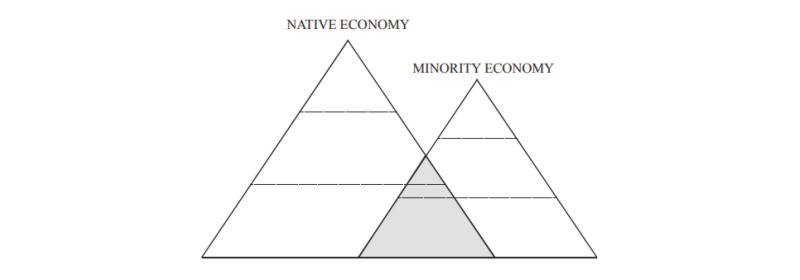
|
|
|
Only at the overlap is trade between the minority and majority populations possible.
|
|
|
The separate pyramid model is consistent with the theory that there exists a caste barrier between the native and minority groups. W. Lloyd Warner in 1936 argued that such a caste barrier existed in the USA with black and white groups each possessing their own distinctive hierarchies, but not relations between the two inhibited by race. However, Marxists reject the theory of a caste barrier, arguing that relations between Black and White are based on exploitation. The theory that minorities occupy an underclass position creates a different model of society.
|
|
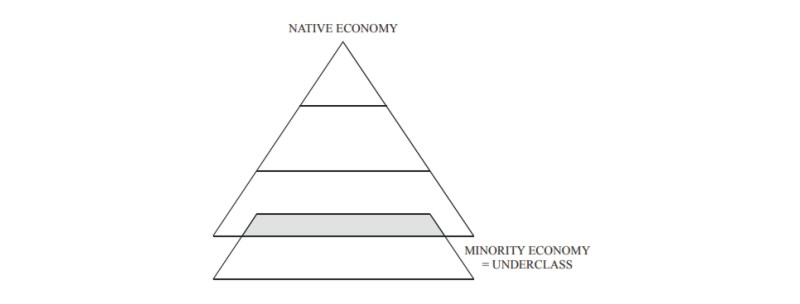
|
|
|
John Rex defines membership of the 'underclass' as being excluded from the benefits of the welfare state. [We note that his definition of the underclass would exclude long-term unemployed, pensioners and invalids — that is, it would exclude other groups that have been said in the past to belong to the underclass..] Thus, membership of the working class confer s rights to “use industrial power”, to work, to have an income when out of work, to be entitled to basic health care, housing, education and personal social services. Members of the underclass do not have these rights. To “use industrial power” is to have the right to collective bargaining over wages and conditions. The right to work includes the right to equal access to employment in a range of different jobs.
|
|
|
Rex poses the following questions: are members of a minority are more liable to unemployment? Do minority members have equal protection before the law and is their experience of the police is the same as members of dominant groups? Do unions “accept the employment of minorities in low-grade jobs, but resist the demands of these workers to enter the more rewarding jobs”? Also, minority employees would be more vulnerable to unemployment should unemployments rise. Immigration law can place additional pressure even on legal immigrants. Competition for limited resources may lead to struggle for housing, that may in turn cause residential segregation.
|
|
|
However, John Rex argues that the position of the Indian community and the Afro-Caribbean community in Britain is different. He believes that the Indian community in Britain conforms to the separate pyramid model, whereas the Afro-Caribbean community corresponds to the underclass model. Regarding the Indian community, he argues at many, perhaps most, immigrant Indians occupied higher status positions in their own countries and brought wealth with them. They have a work ethnic that enables them to move up the “social ladder” and they are also inclined to be entrepreneurs. Second generation immigrants are likely to be well-educated and to enter professional occupations. In fact, as a result of these developments, Rex envisages that the overlap between the separate pyramids will increase over time.
|
|
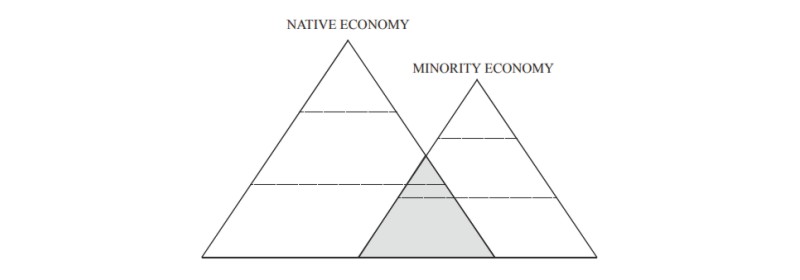
|
|
|
The diagram shows the formation of a class alliance between native and immigrant employers and workers. However, Rex points out that there are two aspects of the psychology of scapegoating that may prevent this desirable development. Firstly, Indians tend to be encouraged to undertake “pariah” occupations. These are activities that are economically and socially necessary, yet judged by society as undesirable, such as providing lodgings for immigrants. Secondly, the practice of scapegoating is the tendency to blame economic disaster on minorities. Indians are scapegoated particularly because of the pariah stereotype that makes them easy victims of such prejudice.
|
|
Race Relations Law |
|
The Race Relations Act of 1965 made racial discrimination a civil wrong, and established a Race Relations Board to administer the Law. However, not a single case went to the Board during the whole lifetime of the Act. The act also made it illegal to incite racial hatred in speech or writing.
|
|
|
The 1968 Race Relations Act extended the provisions of the 1965 Act to cover employment, housing. However, once again the number of cases prosecuted under this law is very small.
|
|
|
The 1976 Race Relations Act created the concept of indirect discrimination. This occurs when, for instance, a job advertisement that is not overtly racist, nonetheless creates restrictions that effectively discriminate against an ethnic minority. The Act created a Commission for Racial Equality which was given the task of promoting racial harmony and providing legal assistance to victims of discrimination. The Commission has had some influence, and was able to persuade Parliament in 1984 to adopt a revised code of practice in employment. It has also investigated the practices of a number of organizations.
|
|